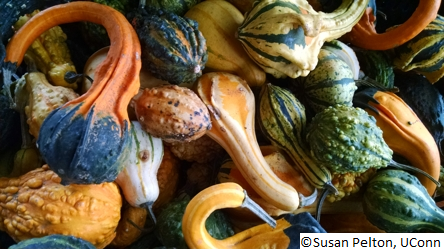Gourds
Gourds belong to the family Cucurbitaceae which consists of 95 genera that include 965 species. This family includes cucumbers, squash, pumpkins, and melons. There are two genera of gourds that are generally grown in Connecticut. The first is Cucurbita, a yellow-flowered gourd which produces fruit that easily damaged by frost even when mature. This group contains fancy gourds that come in a variety of shapes and colors ranging from yellow to orange to green. The other is the species Lagenaria which produce white flowers and fully-matured fruit that are not damaged by frost. These are the dipper, bottle, or sugar trough gourds that require a longer growing season than the Cucurbita varieties.

Cultural Requirements
Both Cucurbita and Lagenaria gourds are rapid-growing annual tendril-bearing vine plants. For best results, especially with the Lagenaria varieties, they should be started indoors 3 to 4 weeks before the last expected frost date. Gourds are monoecious meaning that each plant bears both male and female flowers. They are pollinated by insects.
Gourds should be planted in full sun in a fertile, well-drained soil with a pH between 6.0-6.5. These plants produce an extensive root system and should not be placed too close together. Gourds may be grown as trailing vines or trained on a fence or trellis. If grown on the ground the hills should be spaced at 10-20' intervals. Plants which are trellised can be spaced 4' apart but must be tied to the structure once the vines reach 3' in length. If mesh fencing is used then no tying is needed as the tendrils will hold the vines in place. Gourds are somewhat drought-tolerant although they should be well watered until they are established. Black plastic mulch or an organic mulch such grass clippings or compost may be used at the base of the plants.
Incorporate 3 lbs. of 5-10-5 fertilizer per 100 square feet of area into the soil before planting. A side-dressing of 1/2 cup of 5-10-5 fertilizer can be mixed into the soil 6-8" from the base of the plant once the vines have started to grow, about one month later. Water thoroughly after any fertilizer application.
Diseases and Insects
Many of the insect pests and diseases that plague Cucurbitaceae family members also affect gourds. Common insect pests include striped and spotted cucumber beetles, squash bugs, squash vine borers, melon aphids, red spider mites, leaf miners, wire worms, and slugs.
Diseases such as mosaic virus, powdery and downy mildews, and bacterial wilt may also cause problems. Mildews result in the death of the foliage which then stops fruit development. Mosaic virus can interfere with the proper color development and results in inferior specimens.
Harvesting and Post-Harvest Handling
Cucurbita varieties ripen earlier than Lagenaria types. When fully mature, Cucurbita gourds will become very hard. Gently press the surface of the gourd to check for hardness being careful not to break the skin. Damage will shorten the shelf life. These gourds must be harvested before the frost.
The Lagenaria gourds are fully ripened when they change from green to tan. If left on the vine long enough the seeds will become dry and will rattle when shaken. Mature fruits are not harmed by the frost but hard, immature green gourds should be harvested before the frost. With proper curing they will dry without decay or shrinkage.
Gourds should be harvested on a clear, cool, day. Leave a few inches of stem attached. Wash fruits with mild soapy warm water, rinse and dry. A household disinfectant added to the clear rinse water can reduce the number of soil-borne decay organisms. Place gourds (they should not be touching) on several layers of newspaper in a warm sunny room that has good air circulation. The ideal temperature is 80-85º F. Most gourds will dry in 2-4 weeks. After drying, gourds should be stored at 50-55º F until ready to use.
Gourds may be sprayed with an acrylic resin or lacquer, waxed with floor polish, or shellacked. if shellac is used it should be cut with an equal amount of denatured alcohol. Fruit may be dipped in the shellac or it may be applied with a soft brush. Do not preserve any gourds that show signs of bruising or decay. Keep dried gourds out of direct sunlight to prevent colors fading from the sun.
Despite good cultural practices, pests and diseases at times may appear. Chemical control should be used only after all other methods have failed. For pesticide information please call UConn Home and Garden Education Center or your local cooperative extension office.
The UConn Home & Garden Education Center supports UConn Extension’s mission by providing answers you can trust with research-based information and resources. For gardening questions, contact us toll-free at (877) 486-6271, visit our website at homegarden.cahnr.uconn.edu, or reach out to your local UConn Extension center at cahnr.uconn.edu/extension/locations.
Revised by the UConn Home and Garden Education Center, 2016.